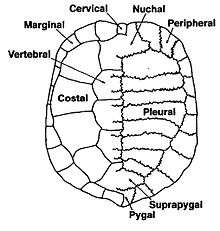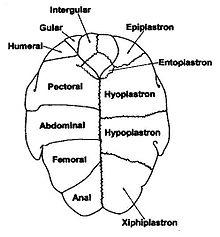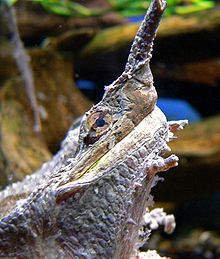
The eastern long-necked turtle is an east Australian species of snake-necked turtle that inhabits a wide variety of water bodies and is an opportunistic feeder. It is a side-necked turtle (Pleurodira), meaning that it bends its head sideways into its shell rather than pulling it directly back.

Chelodina, collectively known as snake-necked turtles, is a large and diverse genus of long-necked chelid turtles with a complicated nomenclatural history. Although in the past, Macrochelodina and Macrodiremys have been considered separate genera and prior to that all the same, they are now considered subgenera of the Chelodina, further Macrochelodina and Macrodiremys are now known to apply to the same species, hence Chelydera is used for the northern snake-necked turtles.

The Pleurodira are one of the two living suborders of turtles, the other being the Cryptodira. The division between these two suborders represents a very deep evolutionary divide between two very different types of turtles. The physical differences between them, although anatomical and largely internal, are nonetheless significant, and the zoogeographic implications of them are substantial. The Pleurodira are known more commonly as the side-necked turtles and the name Pleurodira quite literally translates to side neck, whereas the Cryptodira are known as hidden-necked turtles. The Pleurodira turtles are currently restricted to freshwater habitats in the Southern Hemisphere, largely to Australia, South America, and Africa. Within the Pleurodira, three living families are represented: Chelidae, also known as the Austro-South American side-necked turtles, the Pelomedusidae, also known as the African mud terrapins, and the Podocnemididae, also known as the American side-neck river turtles. However, they were cosmopolitan clade during the Cretaceous and most of the Cenozoic, and even occurred in marine environments around the world.

The Argentine snake-necked turtle, also known commonly as the South American snake-necked turtle is a species of turtle in the family Chelidae. The species is known for the long neck to which its common names refer. Despite appearances, the Argentine snake-necked turtle is probably more closely related to the mata mata than to the Australian snake-necked turtles in the genus Chelodina. H. tectifera is found in northern Argentina, Uruguay, Paraguay, and southern Brazil. Not much is known about it, as it has not been extensively researched. It is a popular pet in the exotic pet trade.
The Namoi River snapping turtle, also commonly known as Bell's turtle, the Namoi River elseya, or Bell's saw-shelled turtle, is a species of turtle in the family Chelidae. The species is endemic to New South Wales, Australia.

Elseya is a genus of large side-necked turtles, commonly known as Australian snapping turtles, in the family Chelidae. Species in the genus Elseya are found in river systems in northern and northeastern Australia and throughout the river systems of New Guinea. They are identified by the presence of alveolar ridges on the triturating surfaces of the mouth and the presence of a complex bridge strut.

Emydura, the Australian short-necked turtles, are a genus of turtles in the family Chelidae. It was paraphyletic with Elseya. Consequently, it was split into two genera Myuchelys and Elseya by Thomson & Georges, 2009. They can grow quite large, 30 cm or more is not unusual and have a life span of around 20–30 years. They generally do not hibernate as their warmer climate lets them remain active all year round; they also spend more time in the water than other varieties. They are considered omnivore but rely on a constant supply of meat to remain healthy, feeding on basically anything that will fit into their mouth.

Hydromedusa is a turtle genus in the family Chelidae, commonly known as the South American snake-necked turtles. They are quite closely related to the South American side-necked swamp turtles (Acanthochelys) and the snake-necked turtles of the Australian-Melanesian region (Chelodina), but less closely to the spine-necked river turtles of South America (Podocnemididae) which belong to a more modern lineage of Pleurodira.

The Fitzroy River turtle is a species of freshwater turtle in the family Chelidae. It is the only surviving member of the genus Rheodytes, the other member being the extinct form Rheodytes devisi. The species is endemic to south eastern Queensland, Australia and only found in tributaries of the Fitzroy River.

Elseya uberrima is a Pliocene species of extinct Australian snapping turtle.
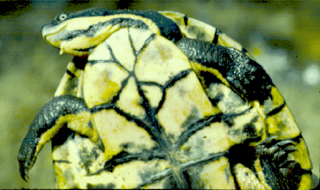
The Myuchelys is a genus of turtles, the Australian saw-shelled turtles, in the family Chelidae and subfamily Chelodininae. They inhabit the headwaters and tributaries of rivers within their range and this led to the name Myuchelys, which is formed from the Aboriginal word myuna meaning clear water and the Greek chelys meaning turtle. They have a short neck and the intergular scute completely separates the gular scutes. They have no alveolar ridge separating them from the snapping turtles of the genus Elseya.
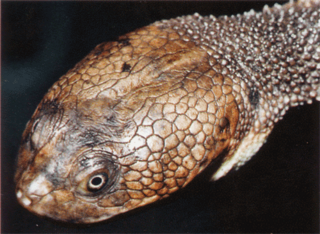
Chelodina canni, also known commonly as Cann's snake-necked turtle, is a species of turtle in the family Chelidae. The species is endemic to Australia, where it is found in the northern and northeastern parts of the continent. It has a narrow zone of hybridization with its related species the eastern snake-necked turtle, C. longicollis. For many years C. canni was assumed to be the same species as C. novaeguineae from New Guinea. However, in 2002 it was shown that these two species differ both morphologically and genetically, and therefore C. canni was separated and described as a unique species.

The Gulf snapping turtle or Lavaracks' turtle is a large species of freshwater turtle in the sidenecked family Chelidae. The species is endemic to northern Australia in northwest Queensland and northeast Northern Territory. The species, similar to other members of the Australian snapping turtles in genus Elseya, only comes ashore to lay eggs and bask. The Gulf snapping turtle is a herbivore and primarily consumes Pandanus and figs.

Chelodina (Chelydera) burrungandjii, the sandstone snake-necked turtle or Arnhem Land long-necked turtle, is a medium-sized turtle reaching carapace lengths of 316 mm. The species is found in the sandstone plateaus and escarpments and the plunge pools of Arnhem Land of the Northern Territory. The species had been long recognised as valid. However, it had been difficult to research due to the remoteness of its habitat. Efforts to breed this species in captivity had been largely unsuccessful, until National Aquarium Herpetologist Matthew Benedict lead a successful breeding project in 2021. The species occurs in proximity to Chelodina rugosa, to which it is closely related. For the most part the two species are parapatric in distribution. However, they do come together in limited locations such as plunge pools at the base of the escarpments. In these areas there is hybridization between the species.
Prochelidella is an extinct genus of Early to Late Cretaceous chelid turtles from the Bajo Barreal, Candeleros, Cerro Barcino and Portezuelo Formations of the Cañadón Asfalto, Golfo San Jorge and Neuquén Basins in Patagonia, Argentina. It includes the following species:
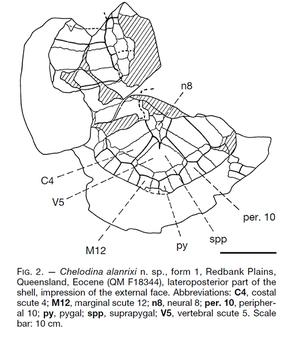
Chelodina alanrixi is a species of snake-necked fossil turtle which was described in 2001 using material gathered in Redbank Plains, Queensland, Australia. It is a member of the Chelidae Pleurodira. The fossil has been dated to the Eocene Epoch.
Yaminuechelys is an extinct genus of chelid turtle from Argentina and the Dorotea Formation of Chile. The genus first appeared during the Late Cretaceous and became extinct during the Late Paleocene.
Lomalatachelys neuquina is an extinct genus and species of chelid turtle from Argentina. The specimen was found in the Loma de La Lata zone approximately 75 km from Neuquen City in north west Patagonia, Argentina.

Elseya rhodini, the southern New Guinea stream turtle, is a recently described aquatic species of chelid turtle found south of the central ranges of New Guinea. It inhabits small streams that flow into the major river drainage's south of the ranges.

Scott A. Thomson is an Australian herpetologist, paleontologist, and taxonomist, specialising in turtles of the family Chelidae.

